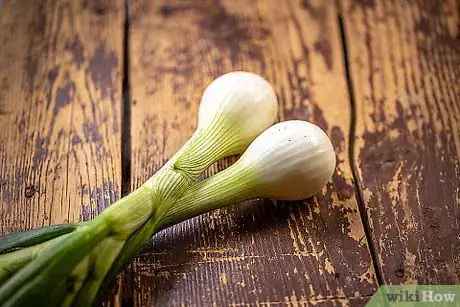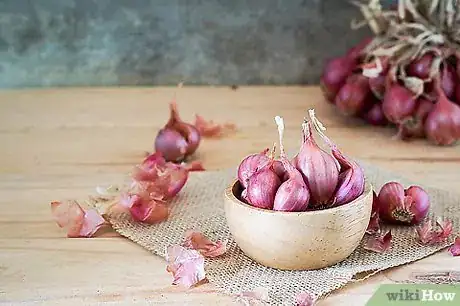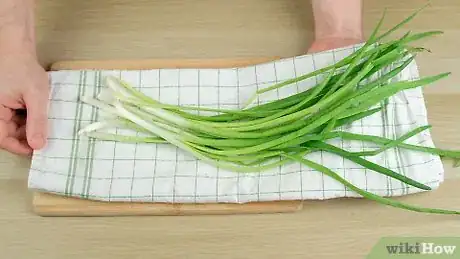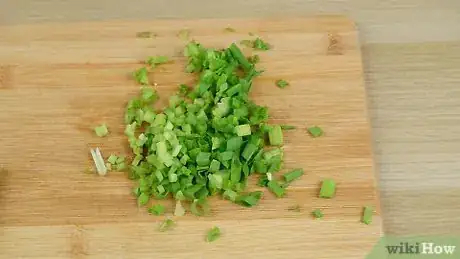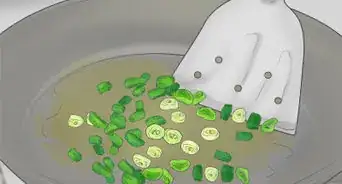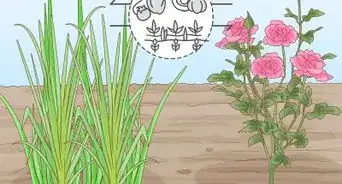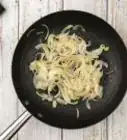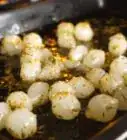This article was co-authored by wikiHow Staff. Our trained team of editors and researchers validate articles for accuracy and comprehensiveness. wikiHow's Content Management Team carefully monitors the work from our editorial staff to ensure that each article is backed by trusted research and meets our high quality standards.
There are 7 references cited in this article, which can be found at the bottom of the page.
The wikiHow Video Team also followed the article's instructions and verified that they work.
This article has been viewed 200,447 times.
Learn more...
It can be difficult to distinguish between spring onions, shallots, and green onions because they all look so similar. Plus, they carry different names in different places, markets, and countries, so it’s easy to get confused! Noticing their physical differences and how their flavors diverge will help you tell them apart so you can use each one in the tastiest way.
Steps
Spotting the Physical Differences
-
1Identify spring onions by their long green stems and white bulbs. Look for something that looks like a tiny onion at the base of a green stem (which fades from lime to emerald green upward from the bulb). The stems are usually thicker and sturdier than green onions to support the bulbs.[1]
- Spring onions are a more mature version of green onions, hence they have a larger bulb.
- Most markets and grocers sell spring onions with the bulbs attached and the tops of the stems trimmed down to about 4 inches (10 cm) to 6 inches (15 cm) long. They’ll often be sold in a batch of 5 or 6 bulbs with the tops attached.
- True to their name, spring onions are harvested in the spring, so depending on where you live, you’re more likely to see them at farmer’s markets around those times.
-
2Notice the bunched, garlic-like clusters that are a hallmark of shallots. If you notice there are small bulbs that look similar to garlic at the base, those are shallots. They grow in tight clusters and typically look a little like small brown onions, only more elongated. You’ll be able to spot them because they aren’t sold with the greens on top.[2]
- Shallots come in purple, brown, and gray varieties (the gray ones are especially rare and considered to be a French delicacy).
- Shallots are harvested in summer and fall, so that’s usually the best time to eat them.
- You can also give them a sniff—they have a zingy, sulfuric smell.
Advertisement -
3Look for a slender, non-bulbous base to recognize a green onion. If the white bulb at the base is long and slender with no bulb or a slightly rounded shape, it’s a green onion. You’ll also notice a small puff of white or tan tendrils (often referred to as the “beard”) coming off of the bottom of the white base.[3]
- Green onions are a more mature version of scallions and have a milder flavor than other varieties.
- Green onions are available throughout the year.
- Green onions are often called spring onions in Canada and the United Kingdom, so know before you go!
-
4Take note of when the varieties are available in supermarkets. Shallots are more likely to show up in stores during the summer and fall while spring onions will show up in the spring and early summer (May and June). Green onions are available year-round, so they might look more familiar to you since they’re more likely to be a store staple. If possible, purchase each variety at the same time so you can do a taste test.[4]
- Keep in mind that the availability of each type may change slightly depending on where you live.
Doing a Taste Test
-
1Look for an onion-like taste to identify spring onions. Wash the spring onion under running water and then separate the bulb from the stem by slicing right where the rounded part starts to expand. Slice the bulb in half going from top to bottom and slice it those 2 halves in half again to make quarters. Taste a sliver and take note if you find the flavor to be similar to a white or yellow onion.[5]
- While spring onions contain less tear-inducing enzymes, they still might make you sniffle or tear up (especially if you’re sensitive to alliums).
- Try using quartered spring onions in place of regular onions for fajitas and other stir-fried dishes.
- You can also leave the bulbs of spring onions whole and use them just like you would pearl onions.
-
2Taste the tops of spring onions and look for a chive-like flavor. Rinse the green tops of spring onions under running water and then dice them into small circular bits. Pop a few bits in your mouth and chew them slowly. If you notice a flavor similar to chives, you have a spring onion.[6]
- Sprinkle the bits on top of roasted meats, baked potatoes, fried rice, eggs, or casseroles before or mid-way through the cooking time.
- Enjoy them raw by adding them to dips like hummus, cream cheese, ranch, or spinach-artichoke dip.
-
3Note the sweet, garlicky taste of shallots. Shallots taste less like white or yellow onions than spring or green onions. Their sweet, zippy taste sets them apart and makes them a great replacement for garlic. Peel off the outer shell of a bulb or two and dice them up. Give it a taste and note the zingy flavor and slightly sulfuric smell (which might make you sniffle).[7]
- Soak the shallots in a bowl of hot water for 2 to 3 minutes to help remove the outer skins.
- Lightly sauté the bits in butter or oil to bring out the shallots’ zippy flavor.
- Try making crispy shallots by frying them in a pan with 1 tablespoon (15 mL) of vegetable, canola, or olive oil.[8]
-
4Notice the milder taste of green onions when you try them raw. Wash the stalk under running water and slice it lengthwise or into rounds about 1⁄4 inch (0.64 cm) thick. Pop some of the white bits from the bottom of the stalk into your mouth and look for an extremely mild onion-like taste. The white part of the green onion has the strongest taste, but it still won’t taste as pungent as the bulb of a spring onion.[9]
- Unlike regular onions and spring onions, green onions won’t make you cry or sniffle at all.
- Sauté whole green onions with 1 tablespoon (15 mL) to 2 tablespoons (30 mL) of olive or canola oil to use in stir-fries and other warm dishes.[10]
- Add sliced green onions to fried rice, noodle dishes, cooked meats, and egg dishes.
- Use raw chopped green onions as a condiment for salads and dips.[11]
Community Q&A
-
QuestionDo chives resemble shallot plants?
 Community AnswerNo. Shallots look like oblong, stretched out onions, while chives look like thick pieces of grass with buds at the top.
Community AnswerNo. Shallots look like oblong, stretched out onions, while chives look like thick pieces of grass with buds at the top. -
QuestionCan they be used in a salad?
 Worlds next polymathCommunity AnswerYes, all three of these vegetables can be used in a salad, though shallots are much better cooked, in my opinion. You could maybe use those in a cooked salad.
Worlds next polymathCommunity AnswerYes, all three of these vegetables can be used in a salad, though shallots are much better cooked, in my opinion. You could maybe use those in a cooked salad. -
QuestionCan I use green spring onions instead of shallots in pickled beets?
 Community AnswerYou can, but shallots tend to have a much more intense flavor than green onions, so it may end up a little mild.
Community AnswerYou can, but shallots tend to have a much more intense flavor than green onions, so it may end up a little mild.
Warnings
- Always wash spring onions, shallots, and green onions before using them.⧼thumbs_response⧽
- If you have irritable bowel syndrome (IBS), spring onions, shallots, and green onions might cause bloating, stomach pain, and other unpleasant conditions.⧼thumbs_response⧽
References
- ↑ https://www.thekitchn.com/whats-the-difference-between-spring-onions-scallions-and-green-onions-word-of-mouth-217111
- ↑ https://spoonuniversity.com/lifestyle/difference-between-shallots-vs-onions
- ↑ https://www.thekitchn.com/whats-the-difference-between-spring-onions-scallions-and-green-onions-word-of-mouth-217111
- ↑ https://www.thekitchn.com/whats-the-difference-between-spring-onions-scallions-and-green-onions-word-of-mouth-217111
- ↑ https://www.thekitchn.com/whats-the-difference-between-spring-onions-scallions-and-green-onions-word-of-mouth-217111
- ↑ https://www.yummymummykitchen.com/2018/04/spring-onions-spring-onion-recipes.html
- ↑ https://www.thekitchn.com/can-you-swap-onions-and-shallots-for-the-other-in-a-recipe-183281
- ↑ https://steamykitchen.com/41593-noodle-soup-with-baby-bok-choy-crispy-shallots.html
- ↑ https://www.thekitchn.com/can-you-swap-onions-and-shallots-for-the-other-in-a-recipe-183281
